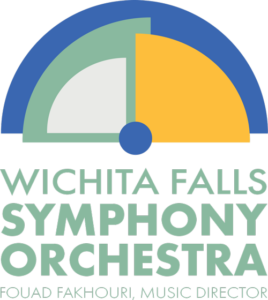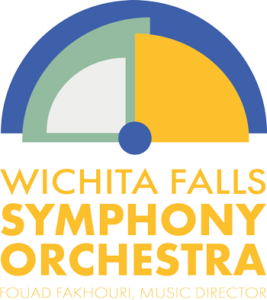Our History
Wichita Falls Symphony Orchestra
Wichita Falls Symphony Orchestra
Originally founded in the 1920s and later reformed in 1947, the Wichita Falls Symphony Orchestra stands as a cornerstone of cultural enrichment in the North Texas region. With a roster of approximately 70 professional musicians and a tradition of hosting renowned guest artists, the WFSO presents a diverse array of classical and pops concerts to the community.
Committed to accessibility, the orchestra offers reduced-price tickets for various groups, including families, students, military personnel, and seniors, while also extending complimentary tickets to active airmen and women from Sheppard Air Force Base. Embracing collaboration, the WFSO partners with local arts organizations to deliver free small-ensemble performances across the community. Moreover, through partnerships with the Wichita Falls ISD and the Wichita Falls Youth Symphony Orchestra, the WFSO enriches the lives of over 3500 students annually with in-school concerts and music education initiatives.
Guided by a dedicated team of staff and overseen by a supportive Board of Directors, the WFSO remains deeply committed to its mission of promoting symphonic music in order to enrich, educate, and entertain diverse audiences in the Texoma community.
Though Harry Daughtery organized the ten to twelve piece Wichita Falls Concert Band in 1888 when the town was still in its infancy, the initial vestiges of an actual orchestra in Wichita Falls date to 1915, when Vienna transplant Ernest Katz established a group of thirty musicians who performed at Everton Music Hall. It was not until 1921, though, that Katz was able to organize the first full-fledged orchestra in Wichita Falls. The orchestra was comprised of 65 musicians, most of whom performed for a living at local moving picture houses. Concerts were held at the Wichita Falls Opera House until 1923, at which time the orchestra disbanded. It was later reassembled under Eitel Allen Nelson, a Paris native, in 1929. Nelson’s iteration of the orchestra performed at Memorial Auditorium for five years until the Great Depression forced it to cease operation. In 1940, Arthur Davis, a violin student of Nelson’s, revived the orchestra for a short time before it too shut down in the spring of 1942 when several of the musicians who were active Sheppard Air Force Base personnel were called to duty at the beginning of World War II.
The orchestra was revived after the War in 1948 under the direction of Frederic Balazs, a twenty-eight year old composer whose works at that time had already been performed by the Budapest String Quartet, the Rochester Philharmonic, and the New York Philharmonic-Symphony. Balazs, a native of Budapest, was also a faculty member of the Hardin School of Music at Hardin College (now Midwestern State University). Under Balazs, the WFSO became the tenth orchestra officially established in Texas. The orchestra was comprised of eighty-three musicians from Wichita Falls and Dallas Fort-Worth. Balazs’ first concert at Memorial Auditorium was on May 9, 1948, and included a chorus of 1000 voices from the city’s grade schools and a 125-voice chorus from North Texas State College (now the University of North Texas), in a performance of Verdi’s Requiem, Schubert’s Symphony No. 8, Strauss’s Blue Danube Waltz, and Berlioz’s Hungarian March. Under Balazs, the WFSO performed four regular subscription concerts each year. Today, the WFSO performs five subscription concerts annually, as well as several small ensemble concerts at various local venues.
Dr. Erno Daniel, also a Hungarian refugee and faculty colleague of Balazs, became the orchestra’s next Musical Director/Conductor in 1952. The following year, the story of the WFSO, including selections from the November 2, 1953 concert, was broadcast in Europe from Stockholm, Sweden as part of Dr. Herbert Bloomstedt’s Symphonies in the United States series that aired on Swedish National Radio. The concert’s program included the music of Bach, Bartok, Rimsky-Korsakov, and Tchaikovsky.
That same year the Wichita Falls Symphony Women’s League was formed. Along with helping sell annual subscription tickets and program advertising, the League also hosted a glamorous annual ball at the Wichita Falls Country Club from 1953 to 2002 to help raise awareness and funds for the WFSO. Changing its name to the Wichita Falls Symphony League in 1992, this volunteer group continues to support the orchestra through fundraising, hosting special events, providing meals to the musicians during rehearsals, offering scholarships to young area musicians, and acting as the WFSO’s official historians.
Dr. Daniel led three important world premieres while with the WFSO, the first of which was Ernst Von Dohnanyi’s Stabat Mater for Treble Chorus and Symphony in January 1956. Dohnanyi, one of the most renowned musical figures to come out of Hungary since Franz Liszt, was well regarded by the likes of Johannes Brahms, who organized the premiere of the younger composer’s 1895 Piano Quintet in C Minor. For the premiere of Dohnanyi’s Stabat Mater, the WFSO was accompanied by the Denton Boys’ Choir and the thirty-two-voice Modern Choir of Texas State College for Women (now Texas Woman’s University). Dr. Daniel had studied with Dohnanyi at the Royal Conservatory of Music in Budapest before the later moved to America in 1949 to escape the Second World War. Here, he became Composer in Residence at Florida State College.
The second world premier led by Dr. Daniel was that of American composer Alan Hovhaness’ Magnificat before an audience of 2,500 on January 26, 1959. The twelve-movement work was performed by a sixty-person orchestra, accompanied by four vocal soloists and seventy members of the Midwestern University Chorus. According to Hovhaness, the Magnificat was composed to “suggest the mystery, inspiration and mysticism of early Christianity.”
While Hovhaness was in Wichita Falls, the orchestra took the unique step of commissioning a work by him to memorialize the dedication and influence of local music patron Mrs. Delia Hawkins Staley of Burkburnett, Texas who had recently passed away. Though Dr. Daniel had already retired from his post as Musical Director/Conductor after the last concert of the 1959-1960 season to lead the Santa Barbara Symphony Orchestra, he was invited back to guest conduct Hovhaness’ new work, the Symphony No. 10, subtitled “Dawn,” in March 1961. Hovhaness, one of the 20th century’s most prolific composers, would go on to write fifty more symphonies throughout his lifetime. Along with the Dohnanyi and Hovhaness premiers under Dr. Daniel, Texomans were also treated to the talents of Metropolitan Opera mezzo-soprano Rise Stevens, cellist Gregor Piatigorsky, and operatic soprano Nadine Conner.
Dr. Walter Charles took the helm of the WFSO following Dr. Daniel’s departure. For his debut with the orchestra, Dr. Charles led Benny Goodman in a performance of Mozart’s Clarinet Concerto in A Major. According to local music critic W. L. Underwood, the audience was nonplused by Goodman’s performance of the Concerto. As he wrote in the Wichita Falls Times Record News, “Possibly his familiarity with the Mozart caused a let-down, but Goodman lacked the personality in the concerto that he showed in [his encore] jam session.” Before ending his brief tenure with the WFSO in the spring of 1964 to assume the conductorship of the Blue Jeans Philharmonic Orchestra in Estes Park, Colorado, Dr. Daniel also led the WFSO in performances with operatic sopranos Nadine Conner and Eleanor Steber.
William Hurst Boyer, a thirty-seven year old Tennessean, was the WFSO’s fifth Musical Director/Conductor. Mr. Boyer, who held a Master’s degree in conducting from the University of Michigan, had studied under conducting greats Eugene Ormandy, George Szell, and Max Rudolph. For his first concert with the WFSO he led internationally acclaimed pianist Van Cliburn, who returned for an encore performance five years later. During Boyer’s twenty year tenure, Texomans were treated to a host of international talent, including Romanian pianist Radu Lupu, Spanish guitarist Carlos Montoya, jazz great Duke Ellington, piano funny man Victor Borge, trumpeter-bandleader Doc Severinson, singer-actor Robert Goulet, guitarists Christopher Parkening and Chet Atkins, and a then seventeen year old Yo-Yo Ma on cello. Mr. Boyer resigned from the WFSO in 1984; hired in his stead was Robert C. Austin, but while arranging the 1985-1986 season over the summer, Mr. Austin unexpectedly resigned.
Theodore Plute, a native of Washington State, was brought in as a resident guest conductor to finish out the 1985-1986 season. Plute was offered the position of Musical Director/Conductor in the spring of 1986, a post he held through the 1994-1995 season. For his first concert of the season, the orchestra’s “Symphony under the Stars” included artillery from the Fourteenth Regiment of the Fourth Division of the United States Marine Corps Reserves in Dallas for the 1812 Overture. Under Plute’s direction, the WFSO performed with guest artists such as violinists Nadja Salerno-Sonnenberg and Robert McDuffie, Spanish guitarists Manuel Barrueco and The Romeros, baritone Sherrill Milnes, trumpeter Rolf Smedvig, harpist Nancy Allen, singer-comedian Shari Lewis and Lamp Chop, and pianists Peter Nero, Steven DeGroote, Barry Douglas, and Alicia De Larrocha.
Dr. Candler Schaffer of West Melbourne, Florida was selected as the seventh conductor of the WFSO in 1996. Dr. Schaffer holds a PhD in Musical Arts in Orchestral Conducting from the University of Iowa. At the time of his hire, Dr. Schaffer was also the conductor of the Florida Space Coast Philharmonic Society, and had served as the Director of Orchestral Studies at both Texas Christian University and Oregon State University.
Dr. Schaffer, as did his predecessors, drew on the rich local musical talent in Wichita Falls and the Metroplex. For example, pianist Dr. Ruth Morrow of Midwestern State University was joined by two of the orchestra’s most important advocates and benefactors, Mrs. Aurora Bolin and Mrs. Dale Prothro, for a performance of Mozart’s Concerto for Three Pianos and Orchestra during the 1999 season opener. Mrs. Bolin and Mrs. Prothro had themselves earlier joined forces with the orchestra in 1968. Mrs. Prothro has performed with the WFSO a total of eight times between 1968 and 2005. Her March 12, 2005 concert was guest-conducted by internationally renowned American composer Michael Torke, who led the Orchestra in a performance of his Color Music.
During Dr. Schaffer’s twenty years with the WFSO he led guest artists such as pianists Santiago Rodriquez, Jon Nakamatsu, Alessio Bax, and Jennifer Koh, clarinetist Richard Stoltzman, the Canadian Brass, fiddle player Mark O’Connor, classical guitarist Sharon Ibsin, and cellist Julie Albers. Dr. Schaffer completed his 20th and final season with the WFSO in the spring of 2016.
The Wichita Falls Symphony Orchestra celebrated two milestones in 2017—providing 70 years of live orchestral music and educational programing in Texoma, and hiring Fouad Fakhouri, our 8th Music Director-Conductor. Maestro Fakhouri, who was chosen out of one hundred four-four highly qualified applicants from around the world, lives in New York with his wife Diane and daughter Bella. A composer himself, he has degrees from West Texas A&M and UNT, as well as from Pennsylvania State University. Dr. Fakhouri has guest-conducted nine other orchestras, including the Lebanese Philharmonic, the Rochester Philharmonic, and the Cairo and Bulgarian symphonies.
The Wichita Falls Symphony Orchestra would like to thank the Wichita Falls Symphony League, without whose dedication to preserving the history of the WFSO through the archiving of newspaper clippings, photographs, and their newsletter, this essay would not have been possible. Bravo, ladies!


